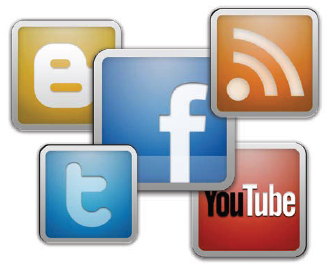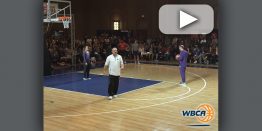| Behind the Lines
originally published in Coaching Women's Basketball magazine
Montana State coach Tricia Binford likes Carrie Underwood, especially those blue shoes she wears in concert and, wow, what balance..."If Carrie can swing herself, hold on and sing amazing, then we can play great transition defense." And James Madison's Kenny Brooks? He jokes about being able to play in the depleted Dallas Cowboys' secondary, and gushes about his daughters, who by the way think Cam Newton might be the cutest athlete in the land. Brooks doesn't care for the Celtics' Paul Pierce; he enjoys Mexican for lunch; and he was one of the first to see "Chronicles of Narnia 3." We know this because they tweeted it. Twitter. Facebook. YouTube. Blogs. Some coaches embrace the evolving social media that connects them to their fans, players, recruits and anyone with the Internet and a curiosity. Along with practice plans, player meetings and administrative duties, many coaches these days are as active on the web as the most technologically savvy teenager. "If 1,500 people are following you, it's a way to brand your program and get your message across," said Frese, who has 1,713 followers on the Twitter account she updates multiple times daily. "Once I learned it, it came pretty naturally. Any time I can use it to promote the team in a positive manner, I do." That includes sharing minute details of her own life at times - and photos of the kids, too. "I think the more people who know that I'm a normal human being, that I have a schedule as a mother juggling twins, the better," she said. "I'm comfortable sharing that family dynamic and who I am." Ditto for Furman coach Jackie Carson, who tweets with similar candor. "I tweet about my shoes, my clothes, what I'm really thinking about," she said. "You hear my excitement and you hear when I'm ticked off. It's a really good way to show your personality." Some coaches use social media strictly for business, and often their Twitter accounts are shared ones among staff. That's the approach Richmond coach Michael Shafer takes. "I read a lot of Twitters and they're being used as personal," he said. "I see no value in that. To each their own. Personally my private life and my family are important to me, and when I go home, I don't want to advertise what it is we're doing. I want to advertise to the world what our team is doing." Not everybody is crazy about the trend. Geno Auriemma doesn't use Twitter much. Neither does Muffet McGraw. "I don't do Facebook, either," said the Notre Dame coach. "My assistants keep it up. I tried it for a week, about a year ago over the summer, and I didn't like it." While McGraw doesn't embrace the intrusive nature of social media, she does believe it plays a role in recruiting. While NCAA rules govern texting and emails, specific rules do not address Twitter and Facebook. It's not unusual for a coach to check a recruit's Facebook page for clues about her. If she lists Italian food as a favorites for example, Carson said she's likely to suggest an Italian restaurant during her recruiting visit. Tennessee assistant Mickie DeMoss was a latecomer to Facebook but has come to realize how much insight it can provide. "It seems that most kids in that age bracket, 16 to 18 years old, tend to check their Facebook more than they check their emails," DeMoss said. "In order for us to keep up with them and in order for them to keep up with us, we had to get on Facebook." DeMoss said Facebook can be helpful, particularly when players are off limits to coaches in terms of contact. "You can see if they just got back from a certain school or who they're friends with," she said. "A lot of times you can tell how interested they are by their Facebook page." Pat Summitt prefers to leave the intricacies of the social media to her assistants, though she attends to it personally at times. "I'm on the phone more than anything else; I'd rather do that," said the Tennessee coach. As for recruiting, "I'd rather be there and let them see me when they're working out or when they're playing. To me that makes the greatest impact - when the head coach walks in the door." While Brooks said he initially thought Twitter was a crazy idea, he has come to see it as a necessary tool to connect, especially when other methods aren't available. "It seems like a lot of people want to follow me and that's humorous," said Brooks, who has 531 followers on Twitter. Brooks said by being personal with his tweets, he can allow recruits to get to know him and the type of program he runs. It also allows him to reach out to recruits in subtle ways. "It's a way to let them know they're special without saying their name," Brooks said. Prior to the early signing period, for example, he wrote: "Special visitors on campus all weekend for Homecoming Weekend. Wouldn't have it any other way. JMU is the place to be."
Fewer coaches blog, but the ones who do love the freedom it gives them to express ideas. Oklahoma's Sherri Coale blogged before it was fashionable, using fun anecdotes to make larger points. One entry reads: "My pet peeve is clothes that are halfway. Every Sunday morning, after my shower and before church, I spend about 20 minutes hanging up the week's clothes that aren't clean but really aren't dirty either. My life is full of them." Her point? "Halfway in basketball can kill you and it's an easy trap for good players to get caught in." In "Bindi's blog," Binford offers glimpses into her Montana State program. A recent blog entry described the Bobcats looking for a Buffalo Wild Wings during a road trip so they could watch the school's football team on TV. Binford said she is more at ease with this format rather than the brevity of Twitter. "Twitter is one- or two-sentence type of deals," she said. "I don't understand Twitter and the purpose behind it. I don't think people are going to be real interested if I'm having a Diet Pepsi at 11 o'clock. In a blog, you have time to tell the story behind it." Arizona State coach Charli Turner-Thorne has recently started what she calls her "Blog of Gratitude." She shares Biblical verses and inspirational messages with Sun Devil fans and players. A recent post calls attention to Bobby McFerrin's song, "Don't Worry. Be Happy." Turner-Thorne writes: "Well, here in the real world . . . It is easier said than done. Anybody else guilty of worrying about things that 'might happen?' I think I read somewhere that 80 percent of the things we worry about never happen!" Undeniably, social media makes it easier for coaches to connect with fans and work to build support for their programs. Carson regularly urges fans to come out to games in her tweets and will remind them of upcoming promotions. Frese tweeted about free tickets for "Maryland Madness" earlier this season and was stunned by the speedy response. "It's amazing how fast things get out," she said. Georgia Tech coach Machelle Joseph said one of the hidden advantages of social media is the stamp it puts on women's basketball. "It has really helped me in a lot of different ways," she said. "It really helps in following women's basketball because we can find scores and stories on other teams. You really have a better pulse on what's going on all over the country. It has made the game more global. All of us know a little more about the opponents and who we're recruiting." |
|
|








